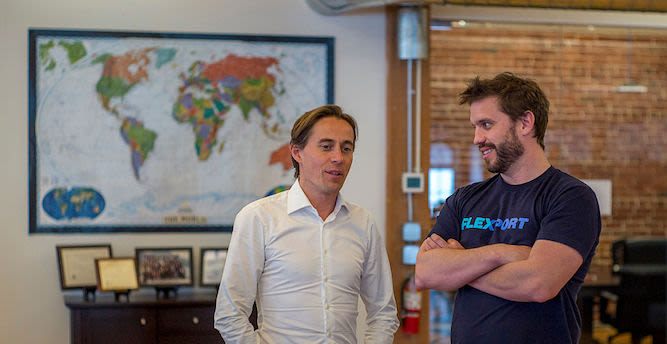
October 22, 2015
Read and Listen to Flexport’s Ryan Petersen on YC’s Startup School Radio
Tags:
Read and Listen to Flexport’s Ryan Petersen on YC’s Startup School Radio

(Ryan Petersen, right, listens to Sanne Manders, COO, at Flexport’s offices in San Francisco.)
I sat down not too long ago with Aaron Harris of Y Combinator to record a session for Startup School Radio. Listen to the podcast here, or find it on iTunes. (This was also published on Wharton’s Business Radio on Sirius XM.)
Thanks to Aaron for a great interview! A lightly-edited transcript of the conversation is below.
What is freight forwarding?
Aaron: Ryan’s going to tell us a little bit on how he got interested in importing and exporting since he was a 17-year-old high school student, and we’ll talk about how his startup is reinventing the freight forwarding business. So when you say Flexport is reinventing freight forwarding, what the heck are we talking about?
Ryan: Well, if you look around in this room, almost everything in here was made in another country. We’re doing a lot of manufacturing so all of these goods can move around the planet. You have to cross boundaries, you have to cross oceans, you have to coordinate between different companies. So what we’re providing is the software that connects everything, it coordinates everybody. And in addition, we’re also the human intelligence layer providing the services that make it works smoothly.
Aaron: So walk us through the trip a car takes from being manufactured in Japan or China and coming to the US. What actually has to happen? How many people touch it? Where does it go? How long does it take?
Ryan: Well, we don’t ship cars, but I can share more insights on finished goods. We do a lot of electronics. First, the manufacturer will need to get the components together. It’s then inspected. Next, it will be picked up by a local trucking company, which will take it from the factory and bring it to port. If it’s airfreight, it’s going to get consolidated with other shipments. The same for smaller ocean freights that won’t fill a full container: it’s going to be mixed and matched.
Aaron: And the containers are those big boxes that you see at back of trucks?
Ryan: Yeah. And so there will be a warehouse that consolidates those shipments. Then someone puts them together, stuffs the container, and fills it up. Then there will be another trucker who brings it to the port and a customs broker who will clear it out of customs.
Aaron: And the broker’s just responsible for filling out the paperwork?
Ryan: Right, and also taxes and licenses to make sure that it’ll pass the regulations. Then the package is loaded to an ocean carrier. A vessel will sail across the ocean and bring it here to a port in the United States. You’ll have a customs broker like Flexport that will clear it through customs. Then it’ll be held until a trucker can pick it up and bring it to a warehouse or fulfillment center. Finally, it gets to retail. So you can see that this is a whole system that requires lots of complex coordination.
The difficulties of importing…
Aaron: So we’re clearly talking about something that’s opaque and not something most people would think about. How did you get here? It doesn’t sound like it’s something that someone stumbles on.
Ryan: Yeah, and it does really does go back to early days; I’m 35 years old, and I started on this business 17 years ago when I was a kid. I was just buying products in China and selling them on the internet and building ecommerce sites. We would find something, arbitrage the prices of Alibaba and other websites in China against the same product.
We were doing stuff before Alibaba was a thing. But when Alibaba came along we were some of the first people arbitraging the eBay price against Alibaba’s price. When we found a 5X difference we’d buy from Alibaba vendors and sell to eBay vendors.
Doing this was what made us realize what it took to move freight and what freight forwarding was.
Aaron: What were the usual problems you actually saw?
Ryan: First of all, I needed a fax machine. Even today I still sometimes need it.
There’s the bill of lading. That’s the shipping manifest. You have to think of it as a plane ticket or passport for cargo; it serves as title to the goods. It’s this physical piece of paper that needs to be flown across the ocean, and if you want to pick up your cargo at the port then you need to present this signed title. That’s still the default in the world today.
By the way, let me tell you the story of DHL. It was founded to solve this problem. In the ‘60s and ‘70s, when container ships started to get more popular, they started to outrun the mail. So you had these containers piling up, waiting for the mail to arrive, just so goods could be released. DHL was founded to solve the problem of creating an express delivery for these paper documents.
Aaron: Let’s go back to when you were a 17-year-old. What were some of the things that really bothered you when you were trying to import things?
Ryan: The biggest one was when goods arrived at the port. If you don’t take it out within seven days then you start to rack up daily charges. They’re pretty outrageous: About $200 per pallet per day. You can have a few dozen pallets in a container, and then you really start to get killed. One reason I couldn’t get them to be released was because I was waiting for a piece of paper that had to be flown across the ocean.
Payments were another real challenge. Nobody takes credit cards or checks in this industry. You have to give a cashier’s check.
Founding Flexport…
Aaron: So you’re seeing these things when you’re 17, 18. How long does it take for you to start Flexport?
Ryan: That was another 10 years or so. I actually moved to China and spent two years running supply chain for the business I started. I spent two years there finding new products, dealing with the supply chain, shipping stuff out. And during my second year I discovered that shipping manifests are all public records. My brother and I quickly realized that the data is really valuable but not easily accessible. So we founded a company called ImportGenius to digitize all 300 million bills of lading to make them searchable. Pretty soon ImportGenius became the largest provider of data to import and export industries.
Aaron: How many bills of lading come into the States every day?
Ryan: It’s roughly about 30,000. We collected them all and made them searchable.
But I always had a nagging feeling that we can do something much bigger. We were seeing all these problems in shipping, but there had to be solutions and software’s probably the answer. Now Flexport is much more than software: We’re a managed service, one that’s improved by software. We provide a full range of services, and our platform gives our customers better visibility and more control over the process of importing.
Not just software: Flexport is about service, too…
Aaron: This is really cool to me because Flexport seems be more than software. To me, the Flexport argument is essentially: Sometimes you need to build vertically-integrated businesses, not just drop software into someone else’s process. Did you know early on that Flexport has to be vertically integrated?
Ryan: Yeah, I think we knew from the start that you had to be full-stack. You have to actually do the work. We’ve hired some really smart engineers to tackle freight forwarding. As we’re building out the tools, our operations managers are sitting across the room, managing quotes and rates. And so the engineers have a very good idea of how they’re solving problems.
I think that there’s going to be a lot more new companies coming up in the next few years who are going to interact with the world in very concrete ways. They’ll be the ones to build software that makes you do that business better. And so we’re very much a full freight forwarder: We move freight all day long for people. At the same time, our customers’ experience is enhanced by software and our transactions costs are lowered by software.
Aaron: This is actually the hardest thing to do because you can’t just drop software on someone and say: “Well, have fun with it. I hope it makes your life better.”
Ryan: Software is clearly better than humans in a lot of things. But humans are also better than software at some things. We’re combining those things and saying: “We’re enhancing human intelligence with the software.”
When humans beat pure software
Aaron: Can you give me an example at Flexport where humans are better?
Ryan: A really good one is our work on the Denied Parties List application. If you want to import or export something, you cannot be on this list. It’s maintained by the U.S. government and every customs broker and freight forwarder has to check that their customers aren’t on it.
Now humans are good at looking at a name and matching it a denied party. We’re not so good at looking at 20,000 names finding if the right one is there. Here’s the thing: The list changes every week or so. The default now is to go to export.gov, download it as a CSV file, put it in Excel, push control + F, and see if a name is matched.
So you need to run this every time anybody ships something. A lot of brokers or companies check it once to make sure that their customers aren’t on there and then they’re done. Now if you want to be compliant, you want to check every shipment. We check every hour because we have software automatically running it through, looking for anything that matches our fuzzy algorithm, and every time saying: “Looks like we have a score of 95% probability here.” And at that point, we have a human looking and making sure that the software is right.
Software is not making the final decision. But it’s really good at identifying a probability that there might be a match. And we’re ready to turn people in.
An industry measured as a double-digit percentages of GDP
Aaron: We’re talking about an incredibly large industry here. Off the top of your head, do you know the value of goods coming in and out of the country every year?
Ryan: Oh, good question. I think it’s over 10 trillion dollars. Trillion with a “T.” And meanwhile, freight forwarding is about a $1 trillion industry. And finally, logistics is about 12% of global GDP.
Aaron: That’s wild; it’s the size of the opportunity, basically. Now when talk to people we find it’s generally easier for a company to start in a smaller market and try to grow that market. You’re coming from the other angle, to a massive market. How do you win?
Ryan: A lot of reasons here. For one, we have a different shade of product: We’ve built really beautiful software and we give people better internal tools to do freight forwarding well.
We also are very focused on segmenting the market. We’re looking for mid-market companies who want software to run their businesses. They use Google Analytics to track their website, and then they have to use a fax machine to do logistics. Those are the companies we most want to be there for. To them we give visibility and control over the product, while being cost-competitive with our peers.
We’ve forced a constraint on ourselves by saying: “Let’s keep ourselves from getting distracted by every shiny opportunity and just stay focused on certain kinds.” If customers are outside of that sector then that’s not a great fit for what we do right now. We have to tell them: “Sorry, we can’t help at the moment.” We will definitely be able to help them later on.
Read this next >> Peter Thiel Leads $20M Series A Investment in Flexport
About the Author





